
Boska, or “Russian Easter Bread”, is a saffron and anise flavored bread of great significance in my family. Of five immediate family members, only two like licorice-flavored items, and only three like saffron. One hates both, but loves boska, and another, somewhat unenthusiastic with both, is the bread's biggest proponent. I'd like to note that the bread does not taste like anise, or saffron, or licorice.
Boska is usually filled with raisins, baked in one or two-pound coffee cans, and then iced with sweet pastel icing. My freshman year r oommate claimed to know what boska was based on its icing and raisins, though I wonder now if she was thinking of kulich, which is decorated in a similar way. We have a neighbor up the street whose sister-in-law bakes boska but calls it “Russian Easter Bread.” (Most Internet searches yielded kulich, but this recipe is quite similar, and includes whiskey. I'm not sure how to interpret the “bohemian” ethnicity, but it's also the only correct find called boska. I don't think the author/submitter is related to my mom's family.)
Our neighbor said her in-laws decorate the rounded top (meant to mimic Russian church domes) with a doily, which is coated in icing, and never eaten. (She said it's buried instead.) Her in-laws are Russian Othodox. We refrain from icing because we don't really like it, I guess, and more importantly, icing prevents us from toasting the bread, which allows the warm, yeasty, comforting flavors to become more pronounced.
We make it every spring—though I successfully encouraged that we baked it in the winter at least once—for Easter. We make 1.5 batches, as one batch does not provide enough loaves for sharing. We send at least one loaf to my grandpa and my aunt, and my mom sent loaves to her daughters when they were in college. Invariably, other people come across our path who are given loaves too—employees, neighbors, and friends. I'm not very religious myself, so you're welcome to make this whenever you want, provided the weather and environment is friendly to bread making conditions.
In addition to toasting, my family recommends using butter as a spread. Peanut butter is considered a sacrilege here, but I think melted peanut butter tastes pretty good, so I encourage it. (We've already removed the raisins and the icing, so I don't see what the harm is by now anyway.)
Recipe
Boska
From the Kitchen of Grandma Helbling
Mm mother's 1 ½ calculations are in parentheses. If the numbers don't seem scientific, rest assured that my mother has adjusted the recipe over the years to ensure a perfect final product.
2 packages dry yeast, fast rising Red Star or Fleishmans ONLY (3)
1 cup warm saffron water (1 ½)
1 TBL. Sugar (1 ½)
1 tsp. salt (1 ½)
1 cup flour (1 ½)
Mix with spoon and let rise 30 minutes.

2 cups cool potato water (3)
1 cup + 2 TBL sugar (1 ½ + 3 TBL)
½ cup butter, melted (¾)
½ cup vegetable oil (¾)
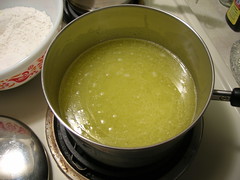
12 egg yolks-stiffly beaten (18)
1 TBL sugar (1 ½)
1 tsp. salt (1 ½)
½ c. whipping cream (¾)
4 tsp. anise (6)
1 TBL yellow food coloring (for a more brilliant yellow) (1 ½)
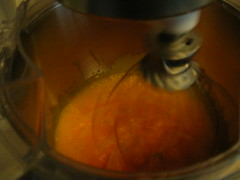
Beat together and add to yeast/potato water mixture.
Add flour (approximately 12 cups—18 if double) to make dough.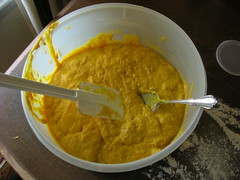
Let rise till double, and work down twice.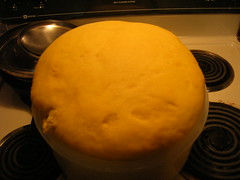
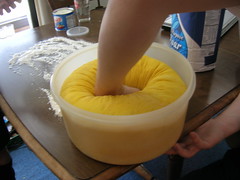
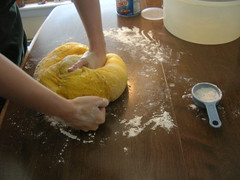
Grease cans with SOLID Crisco. (NOT spray Crisco.) Fill ¼ can and let rise one hour.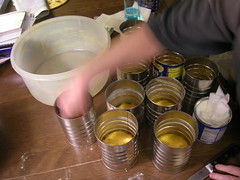
Bake 15 minutes at 350 degrees—then 25 minutes (or until golden brown) at 300 degrees.
Notes
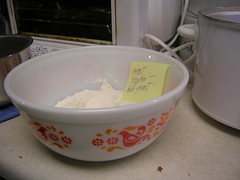
You can start advance preparations one day in advance. My mom says it saves as much as an hour in the morning. This is important because I once waited until 11 a.m. to start and was waiting until after midnight for the bread to bake. You can make the potato water and egg mixture in advance, and of course, you can measure dry ingredients, too. If make the egg mixture in advance mix everything but the anise and refrigerate. Don't forget to add the anise in the morning.
To make potato water, use three potatoes and five cups of water. (Some water will “cook off”, so you will need more than three cups of water in advance to ensure you have three cups of potato water.) Cook potatoes. When I was little my mom saved the water from potatoes she served at dinner.
Drain potatoes. Make sure the water drains into a large bowl. Remove one potato chunk and mash in to the water. Add butter, sugar, and salt. Cover.
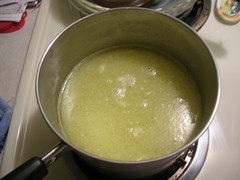
For saffron water, use ½ tsp. saffron threads and 1 ½ c. water. (I like saffron and am more generous. Most recipes want a “scant” teaspoon, whereas I prefer an “almost teaspoon.”) Bring water to a boil and add saffron threads. Lightly press the saffron against sides of the pan (like you would with a teabag) and let steep for fifteen minutes.
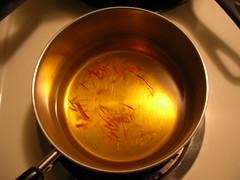
Cover and set aside until you are ready to add to the the yeast. When you are ready, remove the wet saffron threads.
When you separate the egg yolks, you can save the whites in an ice cube tray and freeze for future use. I use whites for macaroons, and Mom saved them this time for a meringue cake.
Heat saffron water (if made in advance) add yeast. Stir carefully, and make sure the only lumps are the ones on your spoon. (Then scrape and de-lump.) Add yeast water to flour mixture and stir carefully. Let rise 20–30 minutes on a warm stove.
Beat egg mixture and add anise. Beat until thick, fluffy, and “lemony.” Add yeast mixture when it has risen, and carefully add 8–10 cups of flour using mixer. We can usually get approximately 8 cups before the mixer has had too much. The dough is then poured onto a clean surface, and I knead in the remaining two (or so) cups.
This dough requires “three” punchdowns. After the third round of kneading, use a large knife to separate the dough. (Mom pulls a lump and slices it.) You'll know if you're done kneading by looking at the dough. Are there a lot of holes?) We use 11 oz. coffee cans to bake the loaves. You want to fill one-third to one-fourth of the can. The dough lump is the size of a grapefruit. Let the dough rise to the top of the cans before baking.
After the loaves are removed from the oven, rub a paper towel with Crisco over the top. (My sister asked why and my mother said, “I don't know. Because Grandma did it.”) This is optional. Let the loaves sit a few minutes, and then using a long metal spatula, run it around the edges of the loaves, between the bread and the coffee can, to loosen the bread. Tip the cans carefully over a towel. (If you tip the cans upside down, quickly turn the bread upright so the top isn't crushed.) Let cool.
The bread tastes best the next day after it has had time to sit. Loaves can be frozen for several months, but good luck with that. You'll want to eat it all before you get the chance.

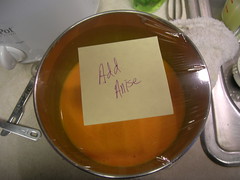





No comments:
Post a Comment